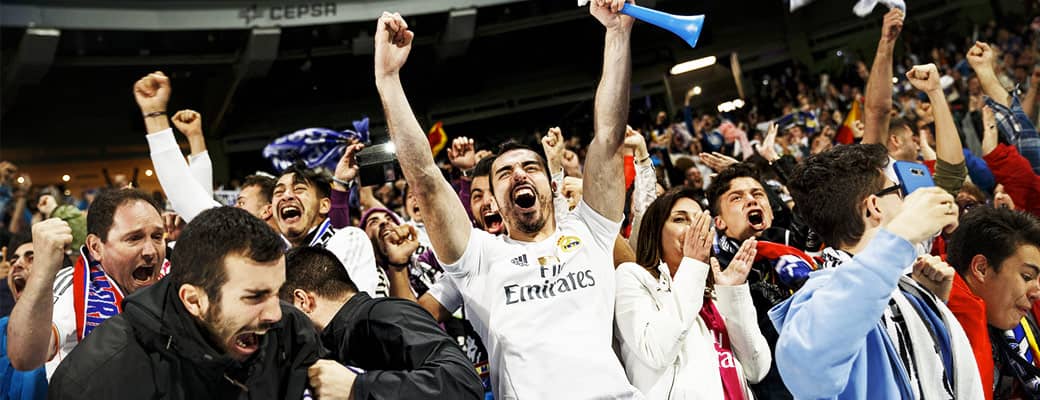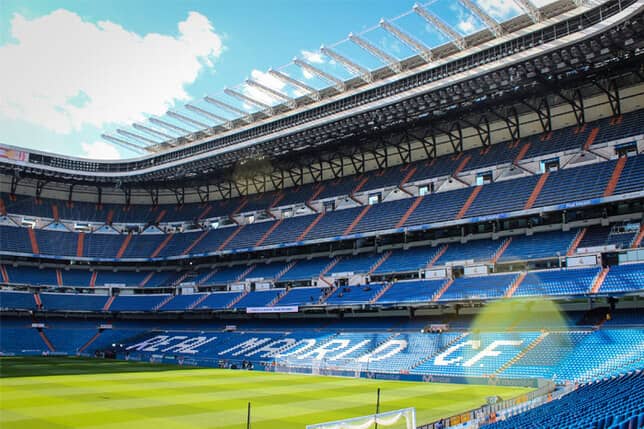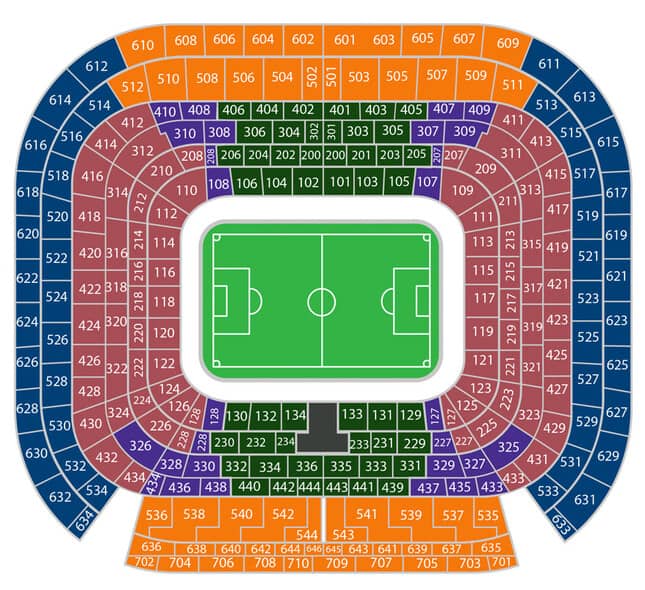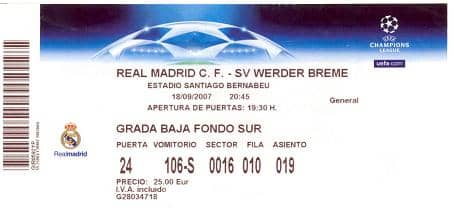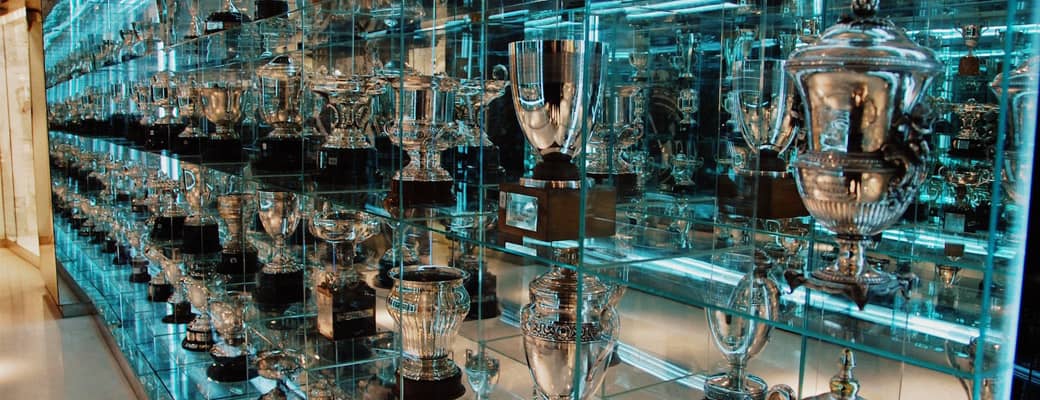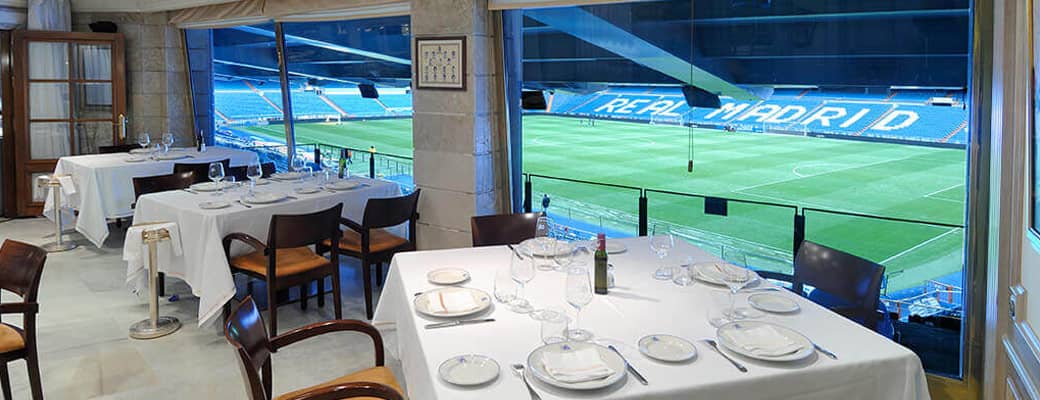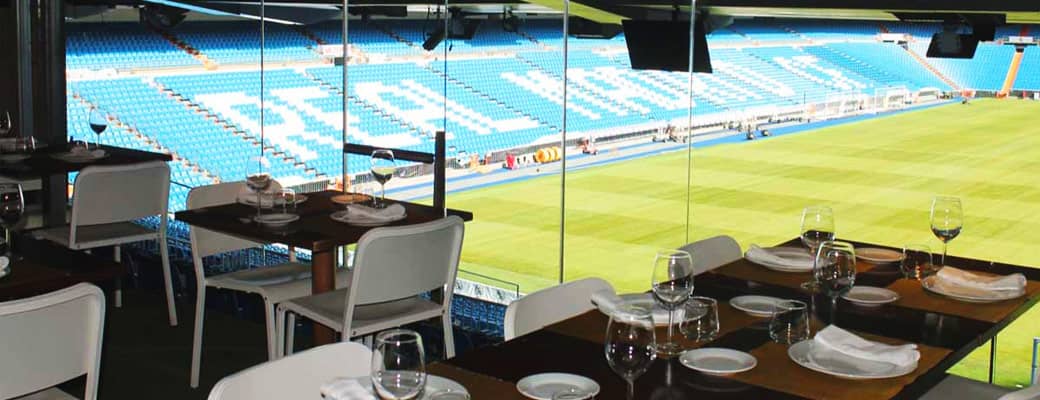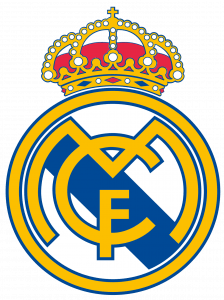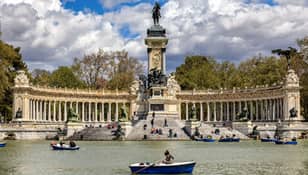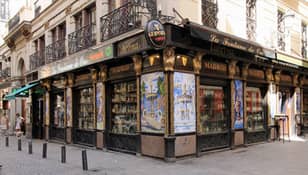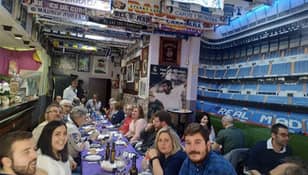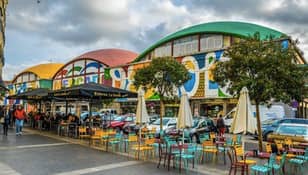Tip! Make sure you have a valid ticket. + Read more
- Paper or e-tickets
- A carefree experience
Real Madrid

Football trip
Real Madrid

Tip! Make sure you have a valid ticket. + Read more
- Paper or e-tickets
- A carefree experience
Tip! Make sure you have a valid ticket. + Read more


Tip! Make sure you have a valid ticket. + Read more
Attend a Real Madrid in the renowned Santiago Bernabéu stadium. A football trip to Real Madrid is a memory you’ll cherish. Santiago Bernabéu offers seating for 81,044 spectators. Real Madrid was selected by UEFA as the best club of the twentieth century. In 2020, they were in third place behind Bayern Munich and FC Barcelona. Marvel at players such as Benzema, Modric and Kroos during your football trip. Aside from the Champions League matches, the derby against fellow Madrileño Atlético Madrid is also something to look forward to. Real Madrid’s major rival is FC Barcelona. There’s an annual blowout during these match ups known as “El Clásico”.
Madrid is the perfect destination for a city break. Make the most of the amazing weather and the inviting outdoor bars.
To ensure your football trip to Real Madrid goes as particularly smoothly as possible, here we have our top tips for you. From insider tips on Santiago Bernabéu football stadium, to great advice on exploring the global city of Madrid.
Ever since 1947, Santiago Bernabéu has been the stadium where “Los Blancos” have played their home games. At 81,044, it’s the second largest stadium in Spain: only Camp Nou is bigger. The stadium is currently undergoing a makeover, with a new roof on its way that can open and close. The venue is named after Santiago Bernabéu de Yeste, who was first a Real Madrid player and went on to spend thirty-five years as its president. With him at the helm Real Madrid burgeoned into a top international club. It is of course possible to take a stadium tour during your football trip to Real Madrid. Read more about this below.
The stadium is found in the northern district of Chamartín, and is easy to reach by public transport. As with several other stadiums, we advise against getting there by car. Parking spaces are few and far between.
This is the easiest way to get to the stadium, with line 10 (dark blue) stops right there. This connection runs through the centre, and is the quickest way of reaching the stadium. Get off at Tribunal or Plaza de España. Buy a ten-journey ticket. This is of obviously cheaper, and a great deal easier than continually buying separate tickets.
Santiago Bernabéu address details
Estadio Santiago Bernabéu
Av. de Concha Espina, 1, 28036 Madrid, Spain
The stadium can also be reached by bus, using the following lines. 14, 27 40, 43, 120, 126, 147 and 150.
Taxis are also a good way of getting to the stadium. Be sure to set off well in advance on match days, when the highway to the stadium is extremely busy.
The sides in Santiago Bernabéu Stadium are:
All of these sides are subdivided into four different categories (and two additional VIP categories).
We will always try to seat you together, but this may not always be the case. If you buy more than one ticket, we will try to get all the seats as close together as possible, grouping you in pairs whenever we can. Different seating options can include: adjacent, diagonally, one behind the other or with a fan or stairway in between.
Experience the thrill of watching Real Madrid live at Santiago Bernabéu with Football Break. Your top choice for exclusive football experiences. Football break offers Real Madrid tickets in combination with hotel bookings, ensuring a seamless and enjoyable trip.
By choosing our 100% certified official tickets, you eliminate the risk of encountering unexpected issues that may arise from unauthorised sources. These official tickets not only ensure your entry into the Santiago Bernabéu but also provide peace of mind, knowing that your football break is backed by the endorsement of reliable channels.
The complete package for a football adventure in Madrid. Certified tickets and an accommodation of your choice. Immerse yourself in the spirit of Madrid and travel seamlessly with our bundled hotel and ticket offerings.
Experience the matchday magic with friends or family as Football Break guarantees that when you purchase tickets for three (?) people, you will be seated together. Share the excitement as you cheer for Real Madrid side by side at Santiago Bernabéu.
Trust the authenticity of your tickets with Football Break. Our tickets are certified original, ensuring a legitimate entry into the Santiago Bernabéu stadium for an authentic Real Madrid experience.
Prices can significantly increase for high-profile matches or special events.
The football trip to Real Madrid is book, and you’ve got your tickets! We’ll be happy to explain how to find your seat.
First, check which side you’re sitting on. Then you’ll see the gate (puerta) where you enter the stadium. After this, look for your Vomitorio: this is the name of a number of sections together. Once here, look at which specific section and which seat you’re sitting in.
Puerta = gate (stadium entrance)
Vomitorio = Number of sections together
Sector = Section you’re sitting in
Fila = Row number
Asiento = Seat number
No football trip to Madrid is complete without a stadium tour. There are a number of different options to choose from. The cost of a tour varies between €20 and €30.
Classic tour
On this tour, you have a guide taking your around the various sights. These feature the players’ tunnel and taking a peek in the “presidential skybox”, and obviously include the trophy cabinet. There’s also a walk around the pitch, the Real Madrid museum and the press room.
Reserve your tickets online well in advance. The groups are of thirty people, and can get full up.
When?
Mondays to Saturdays at 10.30, 12.30, 15.30 and 17.30
Sundays at 11.00, 13.00, 15.00 and 17.00
It’s match day! There are plenty of great spots around Santiago Bernabéu for having a drink and a bite to eat. These places really top off football trip to Real Madrid.
If the ultimate football-trip dinner experience sounds good, book a table in Santiago Bernabéu with views over the pitch. The prices are reasonable, and are between €30 and €50. Eating here is something you’ll never forget; and is ideal for combining with a stadium tour. Reserving in advance is compulsory. If arriving on a match day, be sure to check the opening times.
This bar is also in the stadium. This is the place to come for a drink and spectacular views over the pitch, and is slightly less formal than the restaurant section. This bar consists of two floors: above you have a glass wall eighty metres in length, where you can relax and order a drink.
Real Madrid is of course one of the largest and most recognisable teams in the world. Not just in football, but in all sports. The club was founded in 1902, known as Madrid Football Club at that time. In 1920, the then King Alfonso bestowed the name Real (Royal), and the crown was added to the logo.
Real Madrid’s most significant rivals are FC Barcelona and Atlético Madrid, with “El Clásico” in particular being a match that fans of Los Blancos look forward to the most. The derby against Atlético is also absolutely worth attending.
Los Blancos (the Whites): the name says it all. Ever since the club was founded, Real Madrid has – apart from one season – played its matches in white. The only year this wasn’t the case was in 1925, when they were wearing black shorts. This was because they’d seen Corinthian FC playing in this stylish combination during a tour of England. That fortunately only lasted a year.
With their away kits, Madrid often attempts to include blue or purple, as a reference to the stripe in the logo.
Real Madrid’s very first logo was extremely simple, consisting of its initials only: MFC, Madrid Football Club. Despite its change of name in 1920, Real retained the initials in the logo.
The crown was removed from the logo in 1931, due to the political turmoil in Spain. The logo was given a purple stripe: standing for the Castile region. The crown was to return in 1941 – two years after the civil war – and the purple stripe remained. The purple stripe was made slightly bluer in 2001, and this is the logo we know today.
Madrid is not only the city of Real, but also the beautiful capital of Spain. There is plenty to do and see outside the stadium during your football trip to Real Madrid.
This park has long belonged to the Royal Family, but is now open to everyone. A wonderful, huge park in the very heart of Madrid. Unquestionably worth a visit.
An Irish sports pub, albeit in an entirely Spanish style. Here you can enjoy tapas and a drink, and watch sports games. The place to come for the international atmosphere and Spanish charm.
Don’t walk into here wearing an Atletico Madrid shirt! This compact bar is all about Real Madrid; located on the outskirts, and is ridiculously inexpensive!
This charming, vibrant district is not to be missed during your football trip. This place is packed with restaurants and bars, with all kinds of different markets there on Sundays. Perfect for an afternoon browse.
Initially I was really nervous about booking through a company I’d found online, but I didn’t need to be. The whole booking process and the communication throughout was excellent. It was also good to know that I had the option of 24 hour assistance whilst on my trip if I needed it.
Would definitely recommend to my friends, and I wouldn’t hesitate to book through football break again in the future.
Booking was pretty simple.. booked the game chose the hotel and chose the flight time and date .. the assistance was 100% bang on point .. any questions were answered or worries etc etc .. everything ran like clock work .. flew out day of the match .. the hotel was lovely and was 10 mins in a taxi to the Bernebau .. Madrid also has a great train system that takes you right outside the stadium and is cheap to use .. the game was amazing and was worth every penny to see my sons face light up walking up the steps into the stadium ..I’ll be going again next year and will be booking again .. really well ran business and did everything exactly what was promised .. even had a phone number to use in case of any emergency which I found a great comfort .. match tickets were emailed to be the day before 100% bang on as promised and great seats .. what more can I say ?? Thank you to all
Booking was really easy. This was the first time abroad for me with my daughter who’s 10 years old. Football breaks made it so easy. The level of assistance was second to none and wholeheartedly I would recommend there services to anyone. My daughter is football mad so we went to Madrid v Barcelona. And boy we were not disappointed. Flights were amazing the accommodation was fantastic. And the game was truly the best thing I've ever done. Don’t hesitate to book with these guys. They are genuinely fantastic. Thank you footballbreaks.
Booking was really easy. This was the first time abroad for me with my daughter who’s 10 years old. Football breaks made it so easy. The level of assistance was second to none and wholeheartedly I would recommend there services to anyone.
My daughter is football mad so we went to Madrid v Barcelona. And boy we were not disappointed. Flights were amazing the accommodation was fantastic. And the game was truly the best thing Iv ever done.
Don’t hesitate to book with these guys. They are genuinely fantastic.
Thank you footballbreaks
This is the second time I’ve used football break and this was as excellent a service as the first time, the flight was quick and comfortable and using the metro from the airport is really easy and used it all the weekend. The hotel is modern very clean friendly helpful staff room cleaned everyday and is a great location for everything in Madrid, the Spanish fans of Real Madrid are really friendly and the atmosphere is electric. Booking with football break is so easy and will continue to use them in the future.
Tip: Other than the 2 football teams to watch in Madrid this city is one of the most stunning vibrant cities I’ve been too, please use the open top buses to see the sites they have 2 routes and it’s the best way to see the sites and if you see something you like you can get off and explore and then get back on and carry on they run till 10pm so you can tour Madrid at night all lit up it looks completely different. The royal palace and the parque de Madrid are stunning places to walk around the park is huge with loads of places to grab a drink, food and relax. Madrid is stunning with a street upon street of bars and restaurants I think if you lived there for the next century you’d struggle to eat and drink at every bar and cafe or restaurant.
All very smooth and professionally organised. Made it stress free.
Tip: Get there early for the stadium tour as 30 min queues regardless of when you turn up or if you have booked a time slot. You just join the back of the queue.
What a weekend! We booked via football break to go to Madrid and take my son watch Real Madrid (his favourite team) against Real Sociedad and it was just brilliant! Hotel was great, seats at the Stadium were amazing and they won 4-1! Such brilliant memories and lovely to see the city at the same time. Thank you! ⚽️
Tip: Make sure you go! We were due to go 2 years ago but due to Covid it meant we went this month and it was worth the wait! Pay a bit extra to get the best stadium seats - we did and so glad we did!
